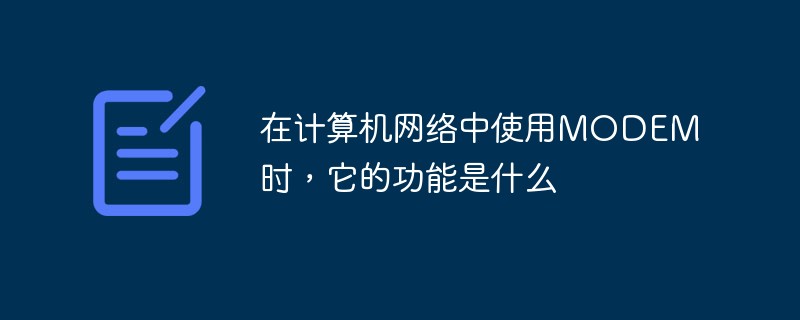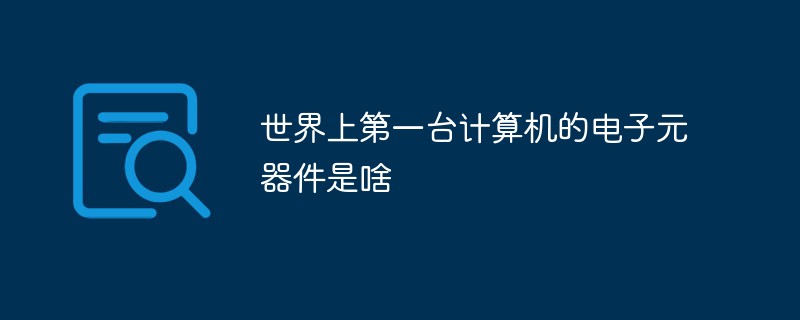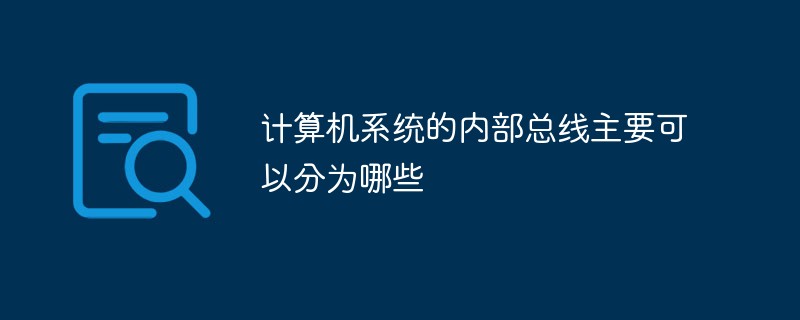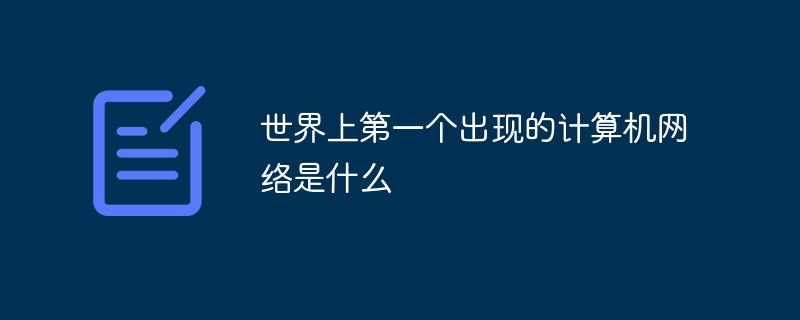The Turing machine is not a computer. It is a theoretical computing model used to describe the basic principles and processes of computing. It was proposed by the British mathematician Alan Turing in the 1930s. The design of the Turing machine is inspired by the process of human mathematical calculations. It is considered one of the theoretical foundations of computers. It consists of an infinitely long paper tape, a read-write head and a series of states. The paper tape is divided into grids, each grid can write a symbol, the read-write head can read and write symbols, and perform state transitions based on the current state and the read symbol.

The operating system for this tutorial: Windows 10 system, DELL G3 computer.
The Turing machine is a theoretical computing model proposed by the British mathematician Alan Turing in the 1930s. The design of the Turing machine is inspired by the process of human mathematical calculations, and it is considered one of the theoretical foundations of computers. However, strictly speaking, a Turing machine is not what we usually call a computer.
A computer is a device that accepts input, processes data, and produces output. It can execute various algorithms and programs and implement various functions. Computers usually consist of two parts: hardware and software. Hardware includes central processing unit (CPU), memory, input and output devices, etc., while software is the program that runs on the computer.
Unlike a computer, a Turing machine is an abstract computing model. It consists of an infinitely long paper tape, a read-write head, and a series of states. The paper tape is divided into grids, and a symbol can be written on each grid. The read-write head can read and write symbols, and perform state transitions based on the current state and the read symbols. Turing machines simulate the computing process through continuous state transitions and symbol reading and writing.
Although Turing machines and computers are similar to some extent, there are also some important differences between them. First, a Turing machine is a theoretical model, while a computer is an actual device. Turing machines are just a way to describe calculations, while computers are tools used to actually perform calculation tasks.
Secondly, the design of Turing machine is simpler and more abstract. It contains only the most basic elements, while computers have more complex structures and functions. Computers are designed taking into account the actual hardware and software implementation, as well as the user's needs and usage patterns.
Finally, the Turing machine is a universal computing model that can simulate any computing process. A computer is a specific device designed to perform specific tasks and applications. Computers can implement different functions by installing different software, but their computing power and resources are limited.
In general, although a Turing machine is an important concept in computer science, it is not what we usually call a computer. Turing machine is a theoretical model used to describe the basic principles and processes of computing. A computer is an actual device used to perform various computing tasks and applications. The Turing machine provides an important thinking and research tool for us to understand the nature of computing, but it is not the computer we use every day.
The above is the detailed content of Is a Turing machine a computer?. For more information, please follow other related articles on the PHP Chinese website!
 根据计算机网络覆盖范围,可将计算机网络分为哪几类Jul 12, 2022 pm 05:13 PM
根据计算机网络覆盖范围,可将计算机网络分为哪几类Jul 12, 2022 pm 05:13 PM根据计算机网络覆盖范围,可将计算机网络分为三类:1、局域网(LAN),是一种在小区域内使用的,由多台计算机组成的网络,覆盖范围通常局限在10千米范围之内;2、广域网(WAN),是一种远程网,涉及长距离的通信,覆盖范围可以是个国家或多个国家,甚至整个世界;3、城域网(MAN),其网络覆盖范围通常可以延伸到整个城市,借助通信光纤将多个局域网联通公用城市网络形成大型网络。
 微机的字长是4个字节这意味着什么Jul 08, 2022 pm 12:04 PM
微机的字长是4个字节这意味着什么Jul 08, 2022 pm 12:04 PM微机的字长是4个字节意味着:在CPU中整体传输和处理的二进制数为32位。因为一个字节是8位长(字长),所以4个字节就是32位了,也就是说cpu中能够同时处理32位的二进制数据。在计算机领域,字是用来表示一次性处理事务的固定长度;一个字的位数,即字长,是计算机一次可处理的二进制数字的数目。
 微型计算机的性能主要取决于什么Jul 13, 2022 pm 03:40 PM
微型计算机的性能主要取决于什么Jul 13, 2022 pm 03:40 PM微型计算机的性能主要取决于CPU(中央处理器)的性能。CPU是计算机系统的运算和控制核心,是对计算机的所有硬件资源(如存储器、输入输出单元) 进行控制调配、执行通用运算的核心硬件单元;中央处理器(CPU)的性能对计算机性能起决定性作用。
 在计算机网络中使用MODEM时,它的功能是什么Jul 11, 2022 pm 12:02 PM
在计算机网络中使用MODEM时,它的功能是什么Jul 11, 2022 pm 12:02 PMMODEM的功能为“实现模拟信号与数字信号之间的相互转换”。MODEM的中文名为“调制解调器”,它可以在发送端通过调制将数字信号转换成通信线路上传输的模拟信号,在接收端通过解调再将模拟信号转换为数字信号。
 世界上第一台计算机的电子元器件是啥Jul 05, 2022 am 10:37 AM
世界上第一台计算机的电子元器件是啥Jul 05, 2022 am 10:37 AM世界上第一台计算机的电子元器件是“电子真空管”。世界上第一台计算机是“阿塔纳索夫-贝瑞计算机”,通常简称ABC计算机,采用电子真空管作为电子元件;该计算机电路系统中装有300个电子真空管执行数字计算与逻辑运算,机器使用电容器来进行数值存储,数据输入采用打孔读卡方法,还采用了二进位制。
 计算机系统的内部总线主要可以分为哪些Jul 11, 2022 pm 02:38 PM
计算机系统的内部总线主要可以分为哪些Jul 11, 2022 pm 02:38 PM计算机系统的内部总线主要可以分为5类:1、数据总线,在CPU与RAM之间来回传送需要处理或是需要储存的数据;2、地址总线,用来指定在RAM之中储存的数据的地址;3、控制总线,将微处理器控制单元的信号,传送到周边设备;4、扩展总线,是外部设备和计算机主机进行数据通信的总线,例如ISA总线,PCI总线;5、局部总线,取代更高速数据传输的扩展总线。
 开机后计算机首先进行设备检测称为什么Jul 08, 2022 pm 05:22 PM
开机后计算机首先进行设备检测称为什么Jul 08, 2022 pm 05:22 PM开机后计算机首先进行设备检测称为“系统自检”。系统自检也称“加电自检”或“post自检”,是指计算机系统,接通电源,自动运行主板BIOS芯片固化程序的行为,包括对CPU、系统主板、基本内存、扩展内存、系统ROM BIOS等器件的测试。自检中如发现有错误,将按两种情况处理:1、对于严重故障(致命性故障)则停机;2、对于非严重故障则给出提示或声音报警信号,等待用户处理。
 世界上第一个出现的计算机网络是什么Jul 12, 2022 pm 03:36 PM
世界上第一个出现的计算机网络是什么Jul 12, 2022 pm 03:36 PM世界上第一个出现的计算机网络是“ARPANET”。ARPANET(阿帕网)是世界上第一个实质意义上的计算机互联网的雏形,是美国国防部高级研究计划署开发的世界上第一个运营的封包交换网络,它是全球互联网的始祖。

Hot AI Tools

Undresser.AI Undress
AI-powered app for creating realistic nude photos

AI Clothes Remover
Online AI tool for removing clothes from photos.

Undress AI Tool
Undress images for free

Clothoff.io
AI clothes remover

AI Hentai Generator
Generate AI Hentai for free.

Hot Article

Hot Tools

SublimeText3 Linux new version
SublimeText3 Linux latest version

Notepad++7.3.1
Easy-to-use and free code editor

Atom editor mac version download
The most popular open source editor

WebStorm Mac version
Useful JavaScript development tools

ZendStudio 13.5.1 Mac
Powerful PHP integrated development environment






